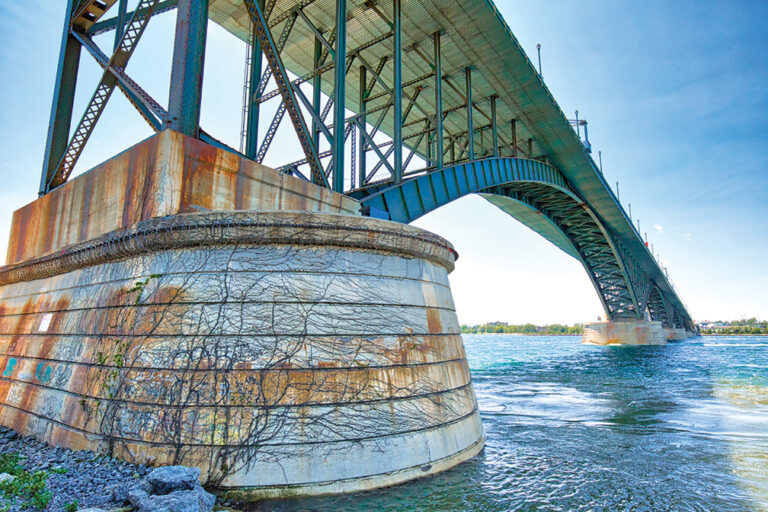The interval between inspections of America’s highway bridges got longer following the June 6 implementation of a final rule by the Federal Highway Administration (FHWA).
This new rule extends inspection requirements for many bridges from two years to four years — and in some cases, six years.
FHWA’s new requirements update the National Bridge Inspection Standards (NBIS) program, which maintains a bridge inventory and reports bridge inspection results — particularly critical findings of structural or safety-related deficiencies — to the FHWA.
The FHWA said the new rule also repeals two outdated regulations, the Highway Bridge Replacement and Rehabilitation Program and the Discretionary Bridge Candidate Rating Factor.
Truckload Carriers Association Manager of Government Affairs Caitlin Smith questioned the federal government’s decision behind the new inspection regulations.
“Expanding the time frame for bridge inspections could undercut the infrastructure spending package, by limiting the timeliness of our knowledge of which bridges need investment now,” she noted. “Considering the poor state of many of the roadways and bridges across the country, we should be advancing efforts to more-directly and comprehensively assess our infrastructure, not do the opposite.”
The Moving Ahead for Progress in the 21st Century Act (MAP-21) required the Secretary of Transportation to update the NBIS.
Through this final rule, the FHWA updates the NBIS to address MAP-21 requirements, incorporates technological advancements including the use of unmanned aircraft systems, and addresses ambiguities identified since the last update to the regulation in 2009.
The regulations prescribe the permissible inspection intervals for bridges, including options for more rigorous, risk-based intervals based on the consideration of certain factors. They also provide options for establishing inspection intervals for each inspection type.
An inspection interval tolerance of three months beyond the inspection date is included.
Specific criteria have been established to allow for extended routine inspection intervals up to 48 months — and up to 72 months for underwater inspections.
Requirements are described to enable the establishment of more rigorous, risk-based intervals in consideration of certain factors associated with bridges for routine, underwater and non-redundant steel tension member inspections that would allow some inspection intervals to be up to 72 months.
One of the bridges that will be affected by the new law is the Interstate 40 bridge that connects Memphis, Tennessee, and West Memphis, Arkansas. That bridge was closed just last year after crews discovered a major crack in a structural beam on May 11, 2021.
Thousands of cars, trucks, and tractor-trailers pass over the I-40 bridge every day of the year. When the crack, which was deemed to be a critical danger to the bridge’s structural integrity, was discovered, the bridge was shut down almost immediately.
In addition to halting traffic on I-40, barge traffic on the Mississippi River under the bridge was temporarily blocked.
The eastbound lanes of the I-40 bridge were reopened July 31, 2021, and the westbound lanes were reopened August 2, 2021.
“The Tennessee Department of Transportation (TDOT) continues to review the new NBIS rules,” said TDOT Director of Structures Division Ted A. Kniazewycz.
“There are many changes that will provide long-term benefits to our program,” he explained. “There is also a considerable amount of new work that will be required to update the documentation on our inventory of over 20,000 bridges. We understand that the new rules will be phased in over the next six years, and we are working with our staff and IT teams to update our computer systems and records to meet the new rule requirements.”
Tito Sanders, a truck driver who lives in Memphis, who says he crosses the I-40 bridge almost every day hauling gravel, shared that it makes him nervous to know there were issues with the bridge that weren’t repaired right away.
“I have a family, and I am all they got,” Sanders said. “I don’t understand why they can’t do more to make sure these bridges are safe. Sure, they say it’s fixed now — but is it really? How do we know? We only know what they tell us.”
Long-haul driver Pam Eaton, who says she crosses the bridge about twice a month, is also concerned about the I-40 bridge, along with other bridges she crosses every day.
“Back in 2002, when the bridge collapsed on I-40 in Oklahoma, I had just gone over it the day before,” she shared. “That really put things into perspective to me. Anything can happen out here on the road. You just have to put your faith in God and keep on going.”
As for the government’s new Bipartisan Infrastructure Law, which will see $2 trillion spent on infrastructure improvements, including bridges, many in the trucking industry are still wondering why more wasn’t included for the industry exclusively.
“Unfortunately, the infrastructure law did not specifically dedicate funds to truck parking — a major concern within the trucking industry,” noted TCA’s Smith. “We will now need to look to Congress and the Department of Transportation to allocate the proper investment to alleviate this expanding issue.”
As for the overall spending package, Smith said TCA is “largely pleased with the infrastructure spending package, as it provides a landmark investment for our nation’s bridges and roadways, which will lead to increased productivity and improved safety.”
However, the funds for that investment should be thoughtfully distributed.
“It is important that the allocation of funds be thoughtfully considered, with officials and industry professionals on the ground steering the conversation to ensure that the money goes where it is needed most,” she continued.
Smith said long-term thinking will be crucial.
“The infrastructure law, through spending on our national electric grid and more, will shape the foundation of our country’s supply chains for years to come and contribute to our preparedness for both the challenges and opportunities that lie ahead,” she said.
“Those implementing the infrastructure spending should pay close attention to supply chain stressors like freight bottlenecks, as well as keep their finger on the pulse of where trucking is headed with electric and hydrogen technologies to best ensure that the future of our infrastructure aligns with the future of private industry,” she concluded.
Linda Garner-Bunch has been with The Trucker since 2020, picking up the reins as managing editor in 2022. Linda has nearly 40 years of experience in the publishing industry, covering topics from the trucking and automotive industry to employment, real estate, home decor, crafts, cooking, weddings, high school sports — you name it, she’s written about it. She is also an experienced photographer, designer and copy editor who has a heartfelt love for the trucking industry, from the driver’s seat to the C-suite.















